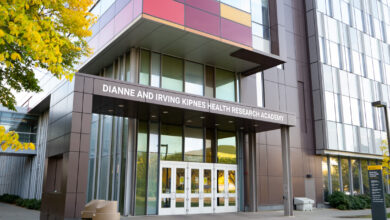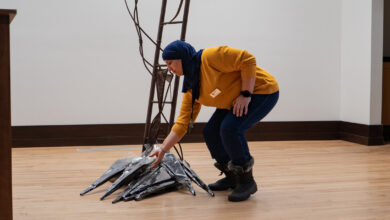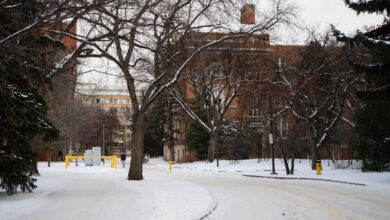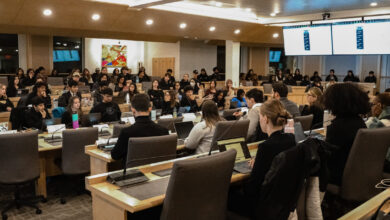SU Elections 2025 Q&A: Vice-president (academic)
There are three candidates in the 2025 vice-president (academic) race: Katie Tamsett, Aamir Mohamed, and Manyu Rathour.
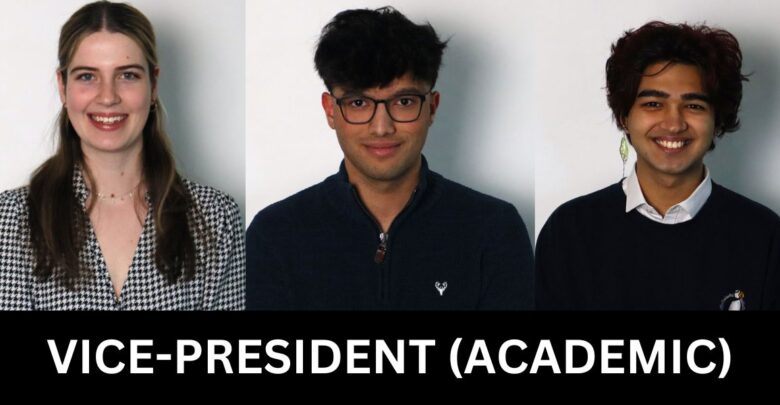 Kathryn Johnson, Liam Hodder
Kathryn Johnson, Liam Hodder The vice-president (academic) of the University of Alberta Students’ Union (SU) is responsible for all advocacy efforts that impact students’ academic experiences. This role involves collaboration with student faculty and department associates. As well, they participate in various boards and committees, such as the SU Policy Committee, General Faculties Council (GFC), and the Council of Faculty Associations (CoFA).
There are three candidates in the 2025 vice-president (academic) race:
- Aamir Mohamed, a third-year computer engineering student and 2023–24 SU faculty of engineering councillor
- Manyu Rathour, a first-year computing science student and 2024–25 GFC science councillor
- Katie Tamsett, a fifth-year human ecology student and 2024–25 SU faculty of agricultural, life, and environmental (ALES) councillor
The following interviews have been edited for brevity and clarity.
Why have you decided to run for vice-president (academic)?
Aamir Mohamed: I’ve come a long way in governance, but I still remember how I got started. I was a first-year international student. I came in, I was very excited and prepared because I’d looked into everything that was there to look [into]. That’s what put me into talking to people and interacting with people more. I was encouraged to run for the president of the Engineering Students’ Society (ESS). I did that [and] got involved.
The engineering program is very intense. That inspired me to be an advocate for different changes there. I spoke to more and more people, connected with council, and the GFC. I then ran for vice-president (external). That brought me into a lot of positions which put me in place to make the changes that I wanted to bring alongside the energy that I had as a first year. Bringing that energy and passion, but now with the experience that I’ve had over the past three years as the president of the ESS and vice-president (external). I want to make that change and take that grassroots level approach to taking the student initiatives and issues to the students and making sure that we’re able to make those impacts.
Manyu Rathour: I’ve seen so many people struggle with a lot of issues during examination time, and I think that accommodating those issues is not always done in the best way. My significant other and my friends have found it really unhelpful and unaccommodating. I really think that I would be able to advocate for better policies if I was vice-president (academic) and that is why I want to run for this. In my time at GFC as a science councillor, I thought that my contributions could be more than just the decision-making, but also advocating for a separate greater cause. That was … the main reason other than my friends not being able to feel properly about accommodations because [accommodations] would change the date last minute, change the place last minute. For people who struggle with anxiety, that’s not really helping them. I, for one, was doing five courses last year, and all of them were math and computer science, even though this was advised to me by an advisor before I was in this country. I thought it was really unhelpful, and I think I could change that.
Katie Tamsett: I’ve decided to run because I’m frustrated with the advocacy systems that we currently have. They’re functional, but they need a wellness check. Especially because most of the time, we’re quite often hit with “it is what it is,” but I don’t believe that because it is a system. There’s so many different interlocking parts that make-up the wider framework. We need to be identifying those gaps and holding everyone accountable to ensure that we are identifying them and addressing them. So [that] then when a student speaks, action will follow.
What would you say are the three main takeaways from your platform?
Mohamed: I would say they are student impact, development, and accessibility. Accessibility ties into all of it, but in terms of impact, we see the SU and all the organizations doing a lot of things. Even the university, every time you go up to them they’re like, “oh, yeah, we have a resource for this,” but then how exactly are students interacting with them? The intent is there, but the impact isn’t matching. We’re going to make sure that we have that impact through the initiatives that the SU does, by interactions with different student groups.
At the same time, we have student development. We have a bunch of events that the SU organizers like the [Student Representative Association] (SRA) Summit, FISL, and Stride [Campaign School] that are all aimed at student development and for representation. But again, looking at the impact of it, relooking at it and making sure that we are able to draw students into it and deliver the way that we want to. Accessibility ties into both of these points in terms of students having those resources, but students not having access to them. My campaign point directly ties into creating a resource of the SU, which has been explored in the past, that students access when they’re in crisis. You look at a resource hub, it’s a bunch of information. Students are not able to actually see what they want, and we want to make sure it’s more accessible. [Make] the [user interface] (UI) itself more accessible, and the fact that students find what they want when they want.
Rathour: My first thing is definitely that people who don’t have psychiatric diagnosis cannot get mental health exam accommodations. Even if they have a diagnosis from a family doctor, which I think is really inconvenient because a lot of people can barely afford to pay for university, let alone get a psychiatric diagnosis. Speaking of not being able to afford university fees, I also advocate for lowering of tuition fees and also more transparency between where the funds are allocated. My third point would be accessibility, accommodation, and inclusivity in academics so that everybody has an equal fair chance at achieving academic success.
Tamsett: My three main takeaways are accountability for academic concerns, menstrual accommodations, and research opportunities. In terms of accountability for academic concerns, this involves again looking at that system and ensuring that when a complaint is made that there is accountability on the end of the professor. The department and the faculty must ensure that that complaint is addressed, because if you take a look at SPOT surveys, students complain, but there isn’t a universal way that SPOT surveys are taken and used. So then how are complaints being addressed through SPOT surveys?
So we’re really looking at tools such as that for menstrual accommodations. They don’t exist and I believe that they should. This will also help aid in the de-stigmatization of menstrual health, and that interlocks with sexual health and really strengthens the way that we understand that and what the issues are.
Thirdly, in terms of research opportunities, I don’t believe that there is enough for students and if there is, how can students know about that? So increasing the accessibility of them and ensuring that students are getting fair access to research opportunities.
With tuition continuing to rise, U of A administration claims these increases are meant to improve education quality. As vice-president (academic), how will you make sure those increases are actually contributing to meaningful improvements in the academic experience?
Mohamed: I don’t agree with the university on the fact that it’s contributing to large scale improvements. Every time the university goes in on the two per cent increase for domestic students and a larger increase for international students, the rhetoric is that they don’t have the money to run the university [how] they want to. That clearly outlines that what they’re doing is just trying to cover the gap and even if the tuition increases, the resources and quality of student life is not improving. This is very evident through the surveys. Even if the U of A rankings are going up, the contributing aspect of student life and student initiatives is bad. Student experience is really bad for the U of A, that’s where the Student Experience Action Plan (SEAP) was launched, but then, maybe we haven’t seen that impact yet.
When Exceptional Tuition Increases (ETI) come into play, especially when ETIs are discussed, we want to make sure that we address them and we actually see quality improvements. How do we do that? I come from a faculty with ETIs. It already happened three years ago, and when they did happen, the university or the SU [or] the SRAs are equipped to make those changes and actually be on the table to make a direct impact. I want to make sure those negotiations happen very clearly and the fact that students’ voices, concerns, and needs are addressed through and through. There’s an accountability matter accompanying it. Currently ETIs are very vague and student accountability just doesn’t exist.
Rathour: I do agree that tuition fees rising is helpful. There’s so many things that are taken into account when you’re paying for your tuition. Classrooms are ever-changing and as suggested before, I am advocating for accessibility accommodation. Our tuition is often allocated into infrastructure, and as vice-president (academic) I could ensure that this is proper. I would ensure that all buildings have easier accessibility accommodation for people with mobility issues and for more active programming for the mental health of students that are already suffering from heavy course load. Active programming that is organized by different organizations so that the funds that are taken from the students get allocated towards people, clubs, and societies that are going to use it for the better cause. A happy student would do much better in academics than someone who doesn’t have equivalent resources that they need.
Tamsett: Affordability is such an important consideration for every student and we expect to get a strong education. I’ve had my own concerns with classes that I’ve taken and I think that, again, we have to look at it as a system and understand why tuition is the cost that it is. Then by having conversations to really fully understand why they’re proposing these different costs, where the money is going, addressing areas where it’s overpriced or where the education itself is lacking. Because I don’t think students should pay high fees if it’s not worth their time, energy, or money.
Academic advising and accommodations fall under the vice-president (academic)’s responsibilities. How would you advocate for the improvement of these services and hold the university accountable to their responsibilities in this area?
Mohamed: The point is, students’ needs and voices are just not heard or they don’t feel like they’re heard, right? When students go up to advising, they don’t feel like they get real answers and real solutions to the problems. We want to make sure that we hear them and we have tangible results available to them through the resource hubs. The students have committed to make these changes, but then we haven’t seen the impact. I want to make sure that we are able to create that one resource hub where students are able to directly find what they want, but at the same time also report concerns at one centralized hub, which currently exists. We have the crisis hub, but it’s just pages of information, which I don’t think is accessible for students in crisis. We want to make sure it’s streamlined, especially when looking at the hiring freeze at the U of A, how exactly those would directly impact the student services.
We want to make sure that there’s one centralized access for students to go, which both the SU execs or the SU vice-president (academic) and students could both monitor. Both of us could come up with a pinch point analysis for what services are lacking and what we need to do, especially with accommodations and such. It’s even more so given that a lot of the policies and things aren’t very clear, especially with the accommodation discrimination and harassment policies that are being discussed right now, and with the accessibility enhancement project that the students are looking at. All of these things need to be relooked at [so] that we always look at the student perspective first.
Rathour: As a student, I try to receive most of the resources that are provided by the university. They are helpful, but I do think that there are more things that could be improved on. In terms of academic advising, this is an ode to Layla Alhussainy, who [is the current vice-president (academic)]. Her main program was academic advising, and she single-handedly brought such a huge change in the academic advising itself. There’s academic success centres. There are so many places where you can access advising for what you’re gonna do with your degree, where it takes you. But I do still believe that accommodation needs a lot of work. As vice-president (academic), I would hold the university accountable towards the accommodations by providing a more substantial lay down of what could be done with exam accommodations and with the needs of the students.
Tamsett: Academic advising is an important aspect of a student’s journey. They need to know that there is support available and I think ultimately it does fall down to the communication of what resources are available. How can a student access these resources? Currently, I don’t fully understand the academic advising system as it exists in each individual faculty, but again it’s looking at the overall system. I know that there are very big concerns, especially in the larger faculties, because students don’t get access to academic advising within a timely manner and that’s a problem, but what do you do? It’s really understanding the system as a whole, breaking down what the individual problems are for students and addressing them as they appear. Students need to be heard and need to have the resources and access to the resources in order to get what they’re paying for.
How will you ensure that decisions that affect the quality of education for students are transparent?
Mohamed: The biggest thing about transparency in anything is making sure students are actually aware. When we look at engagement, the maximum engagement any student group or even the SU gets is 20-25 per cent at max. We need to increase that by creating that channel of communication. Bringing these topics to council and having these very open conversations that get the councilors to talk to [faculty associations] and the vice-president (academic). Having those biweekly meetings with SRAs and getting the SRAs to discuss this in their own councils and board of directors so that it’s a full channel of student leaders discussing it. But at the same time creating interactive marketing and communication strategies to directly engage with students. Creating that large scale governance network. That’s why the SRA summit needs to be relooked at to ensure that these student groups, SRAs, departments and programs, and students are involved in capturing them first.
Rahour: There are many platforms that already do so, but I would suggest that the many other governing bodies ensure that these decisions made and votes passed are more visible to students. Through either social media, SUTV, CJSR radio, or The Gateway. I would want everything to be open for students to actively vote for. It would be my responsibility as vice-president (academic) to be a representative for students. But that does not mean that the students themselves should not have a say for themselves. I am only one person and I believe in the voice of all.
Tamsett: I think the SU attempts to be as transparent as possible, but ultimately it’s a communication issue. We do have so many resources available, but how do you communicate them to students? I fundamentally believe in collaboration and communication because I’m not the expert on individual experiences as students, but I am in terms of system navigation. I would make myself available to students to build relationships, constantly providing updates especially to the student groups and faculty associations to ensure that there is a chain. Where the information in theory does get down, but then also building the student governance structure, such as CoFA and GFC, and strengthening those relationships and really using CoFA to provide very strong updates. But also to collaborate on these concerns and hear from them.

